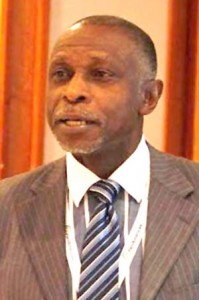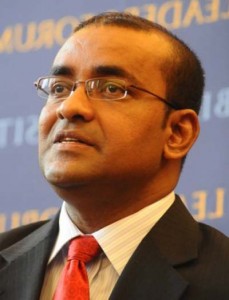Latest update March 20th, 2025 3:58 AM
Latest News
- Guyana’s oil growth boosting regional economies– CDB Director of Economics
- Suspected outbreak of Hand, Foot and Mouth Disease in Region Four
- Israel launches first ground offensive since Gaza ceasefire collapse
- Sod turned for $665M expansion of St. Stanislaus College
- Pensioner jailed for raping child
Current external debt significantly higher than past PNC, PPP Govts
Mar 31, 2015 News
Former President Bharrat Jagdeo lambasted the record of former PNC Finance Minister Carl Greenidge
during that party’s reign and dubbed him the country’s worst finance minister ever, after the largest external debt was accumulated while he was in office.
Today, the former President has himself been accused of helping to take the country’s current external debt significantly higher than that attained by both past PNC and PPP governments.
Jagdeo during a press conference at Freedom House on Saturday spoke extensively about financial decay under Greenidge. He spoke of Greenidge presiding over an economic recession, growth in debt, the worst economic strategy and making the country uncreditworthy.
Greenidge on the said matter, he noted that currently, Guyana within an eight-year period accumulated a higher external debt than both the PNC and PPP Governments. He highlighted that during his time as Finance Minister, there were several issues which contributed to the high external debt; and not “irresponsible borrowing.”
He said that Guyana experienced its debt being written off since the 1990s. The Inter-American Development Bank (IDB) in later years was one of the last institutions to make a major write off to the country.
He said that while Jagdeo was President, US$500M was also written off, “but already we have borrowed in the space of eight years (2006 to 2014) the debt is a multiple of what the PPP and PNC had borrowed in the 1960s and 70s.”
“The stock of external debt is close to $2B with no significant arrears in it. This is what we (Guyana) have
borrowed. It is a massive amount of borrowing which amounts to nearly 70 percent of our GDP. And while 70 percent might not appear to be a heavy amount internationally, it is borrowed by a country prone to pressure on its exports. And in the last few years export earnings have not grown significantly.”
Greenidge referred to measures to avoid high debts when he explained that countries must have debt policies. He said before and during the time Guyana ran into debt problems in the 1980s together with Latin America, there were two major debt crises in 1980s and 1990s. Among the most prominent victims of this crisis was Mexico, Argentina. Guyana reacted like some other countries and stopped paying the debt.
But with an economic recovery programme, fashioned and managed by him, Greenidge said that beginning in 1988, “we were able to overcome. One of the things we did was try to set out a debt policy, which sought to keep debt service burden within certain limits. That was overtaken by debt write offs that took place.
“It gave the government a lot of room. This write off began in 1990 under the ‘economic recovery programme’ and it was that so called track record that enabled the PPP government to get the write offs… while the former president was up in the air as if it was all his work to get the debt written off.”
Greenidge continued, “Between Burnham and Jagan governments, they borrowed little over US$600M. By the time interest rate increases of the late 1970s took place; labor going out of the window- and the penalties for late or non-payment of debt took effect, we arrived in 1990 with a debt stock of $2.1B. So you borrowed US$600M and by 1990 you required to US$2.1B. Penalty, interest and arrears… the arrears were a multiple of the amount borrowed.”
“Mr. Jagdeo, in typical Jagdeo style, does not care to ever draw that distinction that it was not irresponsible government borrowing that led to the large debt. You hear people talking about squandermania and all sorts of things done by the Burnham government, but in fact, the reason why this accumulated was because exports also fell.
“Problems arose with alumina, our major foreign exchange earner. The industry collapsed in 1982 and our markets were undermined by competitors, including China, a major rival.”
The opposition economic point man said, “When a country borrows, it repays with export earnings. You cannot have a situation which is sustainable; when export earnings are increasing by one percent a year or negative, and borrowing is going up at plus five percent per annum.”
Borrowing must be consistent with export earnings and money must go to uses that will yield a low capital output ratio. “When a dollar is used it should generate 1.1 or 1.2 return. But that is not happening, for example, with the Skeldon (sugar factory), where the dollar you borrowed is generating a negative because you built a factory and it is operating at a loss. One must look at the “incremental capital output ratio;” the use to which the money is put.”
That is the current Administration’s challenge, Greenidge charged. “To borrow within sensible limits, and put the money to good use.”
Share this:
- Click to print (Opens in new window)
- Click to email a link to a friend (Opens in new window)
- Click to share on Facebook (Opens in new window)
- Click to share on WhatsApp (Opens in new window)
- Click to share on Twitter (Opens in new window)
- Click to share on Pinterest (Opens in new window)
- Click to share on Pocket (Opens in new window)
- Click to share on Tumblr (Opens in new window)
- Click to share on Reddit (Opens in new window)
- Click to share on LinkedIn (Opens in new window)
Related
Similar Articles

The Glenn Lall Show|| March, 17th, 2025
Follow on Tik Tok @Glennlall
THE BLUNT OF THE DAY

Sports
Mar 19, 2025
-20 teams from 16 countries registered for One Guyana 3×3 Quest Kaieteur Sports- The Maloney Pacers, one of the most experienced squads in the Caribbean, will represent Trinidad and Tobago at...Features/Columnists
No immigrant should feel safe in America today
Peeping Tom… Kaieteur News- There was a time when an illegal immigrant in America could live in the shadows with some... more
If Guyana’s President Ali is the “Zelensky of the Caribbean”, who is the Putin?
Antigua and Barbuda’s Ambassador to the US and the OAS, Ronald Sanders By Sir Ronald Sanders Kaieteur News- In the latest... more
Publisher’s Note
Freedom of speech is our core value at Kaieteur News. If the letter/e-mail you sent was not published, and you believe that its contents were not libellous, let us know, please contact us by phone or email.
Feel free to send us your comments and/or criticisms.
Contact: 624-6456; 225-8452; 225-8458; 225-8463; 225-8465; 225-8473 or 225-8491.
Or by Email: [email protected] / [email protected]
Weekend Cartoon

















